#for the curious: i picked up some stir fry beef at the store and while i chopped cilantro/onion/radish/cukes i let it sit in a combo of:
Explore tagged Tumblr posts
Text
i made korean tacos for dinner (no recipe just vibes + what i had in the fridge) and they were unbelievably delicious. my god.
#with a lil hazy ipa on the side!!!!!!#i forgot how EASY and GOOD tacos are to just have fun with.#for the curious: i picked up some stir fry beef at the store and while i chopped cilantro/onion/radish/cukes i let it sit in a combo of:#gochujang + fish sauce + rice vinegar (a dash) + garlic + chili powder + cumin + black pepper + salt + lime juice + onion powder#(just a bunch of stuff i had laying around - use what you have or can get)#then after the veggies were chopped and ready to go i tossed all the meat in a wok and cooked it up#THEN after pulling out the meat i threw a couple tortillas in the wok one at a time and sprinkled some cheese on one side to melt and get#a lil crispy...and also mixed some mayo + sriracha into a sauce for drizzling#(i would've used sour cream instead of mayo if i'd had any but mine was bad T-T)#also i'm out if kimchi or i would've put that on top too. god that would've been so good. i'm kinda mad abt it#anyway then i filled the tortillas with the meat + cilantro + onion + cucumber + radish and drizzled on some sauce.#divine. transcendent. revelatory.#i absolutely love how well korean (honestly a lot of different asian) seasonings and flavor profiles pair with mexican foods and flavors.#CULINARY SYNERGY!!!!#i know this is not a new observation but it still brings me joy every time i remember#anyway fair warning i like spicy food so this is spicy. obviously.
4 notes
·
View notes
Text
Kuala Lumpur, Malaysia
Day 144 – Singapore to Kuala Lumpur
My final day in Singapore was packed with life-admin, complete with many visa arrangements, accommodation, ferry and flight bookings for the rest of my time in South East Asia. I bounced around the little shops in Chinatown, picking up everything from a replacement tripod and medications, to Tiger Balm for my still-recovering knee. I figured this was a good time to stock up on the essentials before I began hostel hopping through Malaysia, Thailand, Laos, Cambodia and Vietnam over the following 7 weeks. After a final hawker centre meal, I packed up my bag and headed back to Changi Airport, boarding a 7:30pm Air Asia Flight to Kuala Lumpur, Malaysia.
After a short, 1-hour flight North, I arrived in KL in the early evening, easily passing through customs and boarding the metro from KL Sentral to Pasar Seni. Arriving in Chinatown after dark, I headed to my nearby hostel, Mingle, which had come highly recommend to me from a fellow traveller I had met in Morocco. The air in Kuala Lumpur was thick with humidity, and I was immediately drenched with sweat after only a few minutes of walking. Even after dark, the pre-war architecture of Chinatown was fascinating. Multi storied shophouses were on every corner - some tastefully restored and painted, some weather-beaten and water stained. Large flickering billboards hung over the streets. It also felt like a neighbourhood that never sleeps! Restaurant and bar customers spilled out into the streets, sitting on bright plastic stools and eating at low tables set up on the sidewalks. My hostel for the next 3 nights, Mingle, was in a historic building, the white walls streaked with black stains, having weathered years of colonial rule and World War 2. Inside, the hostel itself had been tastefully refurbished, while also keeping many of the historic touches from the century-old original construction. I immediately crashed for the night on arrival, gearing up for a busy few days of travelling around the lively capital of Malaysia.
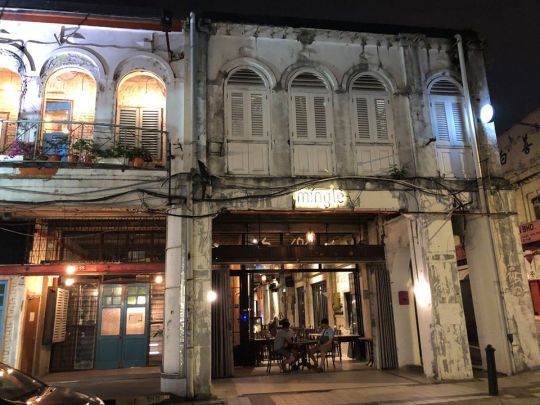
Mingle Hostel in Chinatown
Day 145 – Kuala Lumpur and Batu Caves
Enjoying breakfast on the rooftop terrace of my hostel, I met Jannes, a German traveller who had also recently arrived in KL. Since we were both planning on heading to the Batu Caves that day, we joined forces, hailing a Grab (Asia’s counterpart to Uber) and setting out to our destination, 30 minutes north of the city. It was fascinating to get a sense of the scale of Kuala Lumpur as we drove – the greater city area - called the Klang Valley - is home to over 7.5 million people, and is one of the fastest growing metropolitan areas in Southeast Asia, both in population and economic power. The Malaysian capital is also known for its multicultural population, made up primarily of Malay, Indian and Chinese residents – resulting in a fusion of cultures and religions, vibrant events and festivities, and incredible local cuisine.

Streets of Kuala Lumpur
The morning sun was already furiously beating down as we arrived at the Batu Caves, located in a large limestone hill. This 100-year-old Hindu temple is an important religious landmark, with three massive, naturally formed limestone caves which have been turned into shrines. As we approached the entry gate and took in the massive limestone hill, I caught sight of the colossal, gold statue of the Hindu deity Murugan, towering 140 feet high in front of the staircase leading to the caves. Passing underneath the statue, we began to ascend the 272 steps towards the grottoes. Hundreds of curious macaque monkeys scampered around the limestone cliffs and darted along the stairs next to us. We kept our belongings close to us – as these monkeys are notorious pickpockets!
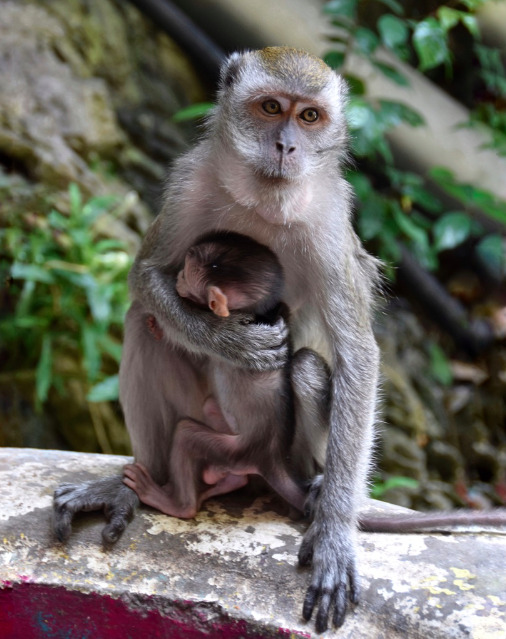
Macaque Monkeys
Arriving at the top of the stairs, we entered the gigantic, limestone cavern, with craggy rock formations hanging from the vaulted ceiling, and smaller crevices and caverns leading away from the main “Cathedral Cave”. We spent the next hour wandering through the enormous caves, scattered with numerous Hindu shrines, dedicated to different deities. Swirling plumes of incense followed us as we wandered along. The towering limestone ceilings had a few large holes, letting in the sun and illuminating the caves in a mesmerizing way. The caves were a truly impressive sight.

Batu Caves

Jannes and I hailed another Grab for a ride back into the city, ready to tuck into to a delicious Malaysian lunch. We were directed to the nearby Old China Café – a cosy Peranakan café serving delicious Chinese Malay dishes such as Char Kuey Teow (flat noodle stir-fry), Lemak Nenas (pineapple prawn curry), Teh Tarik (a hot milk tea prepared with condensed milk), blue coconut rice, and Nasi Lemak (a dish cooked in a pandan leaf with coconut milk). My first venture into Malaysian cuisine certainly did not disappoint – with Malaysia ultimately ending up being my favourite country for food throughout all of my travels!
Returning to our hostel, we met up with other travellers Jannes had previously befriended– Bart from Brussels, Caroline from London, and Egle, a true citizen of the world, who had lived across Europe, Shanghai, and was in the process of moving to Byron Bay to study yoga. In the afternoon, Jannes, Bart and I set out to explore Chinatown. We first visited Sri Mahamariamman Temple, the oldest Hindu temple in Kuala Lumpur. A ornate, 5-tiered Gopuram tower rose above the entrance, sculpted with colourful depictions of numerous Hindu deities. Taking off our shoes, we wandered the edge of the main prayer hall, quietly taking in the relaxed atmosphere and colourful murals while trying not to disturb the worshippers.
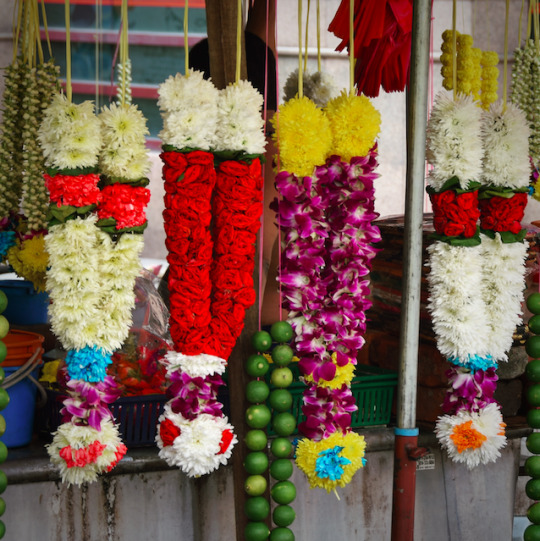
We continued onwards to Petaling Street Market. Formerly the location of a tapioca mill, modern-day Petaling street is a flea market, chock-a-block with shops, food stalls, selling everything under the sun – fake branded items, Malaysian cuisine, fishmongers, souvenirs, and local goods. At night, the whole area transforms into a vibrant night market, with vendors selling countless discount items for only a few Ringgits. Heading a few blocks over, we walked through Central Market, also known as Pasar Seni, which is a handicrafts market, and the former location of a wet market. We spend some time poking around the different stores, with items such as batik prints, paintings and Chinese herbs, to palmistry booths and pearl vendors from Malaysian Borneo.
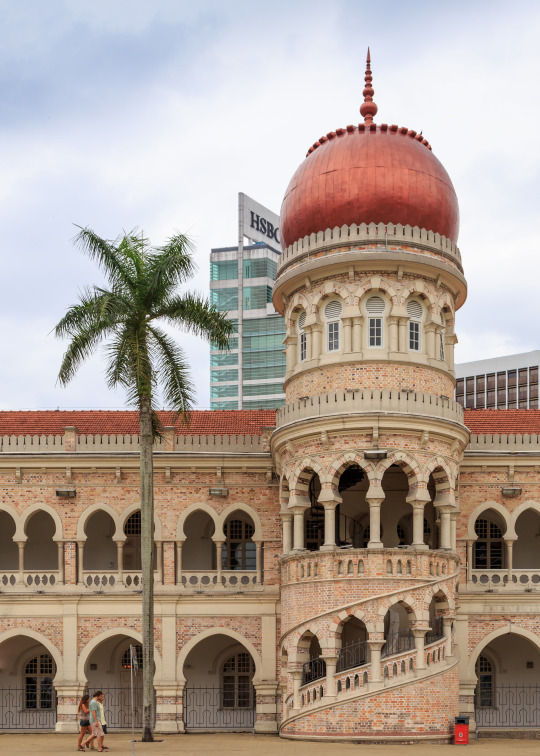
Sultan Abdul Samad Building
Leaving the markets behind, we walked along the banks of the Klang and Gombak rivers, taking in the spectacular architecture along our way – in particular the Sultan Abdul Samad Building, a 1800s heritage building which originally housed the offices of the British colonial administration prior to Malaysia’s independence in 1957. The long building hosts several impressive architectural features, from onion-shaped copper domes and dozens of pink and white bricked archways, to spiral staircases and a central clock-tower designed to echo London’s Big Ben.
At the confluence of the two rivers sits the Masjid Jamek of Kuala Lumpur, a century-old mosque. Built with red brick and marble, the striking designs of the mosque incorporates Moorish and north Indian Islamic architecture.

Masjid Jamek of Kuala Lumpur
As we continued along the river, we became gradually more fatigued from the overpowering heat, finally stopping for a cold Angkor beer on a covered patio. Relaxing in the shade, we recharged our batteries before heading back to our hostel, meeting up with Caroline. Our group headed out for dinner in Chinatown, sitting on tiny red stools along the sidewalk and sharing Malaysian dishes, including Hokkien Fried Noodles, Beef Char Kuey Teow, and even trying a Fried Frog and Ginger dish! For my second meal out – I continued to be blown away by how good Malaysian food was.
As night fell, we haggled with a taxi and caught a ride to Kuala Lumpur’s City Centre, (or “KLCC”), the modern epicentre of the city, complete with futuristic skyscrapers, office towers, upscale shopping centres, luxury hotels and dining. The most famous landmarks in the centre of KLCC are the Petronas Twin Towers, 88-storey buildings with a bridge joining the towers at the 41st and 42nd floors. At night, the towers are lit up, giving them a dazzling, spaceship-like aura.
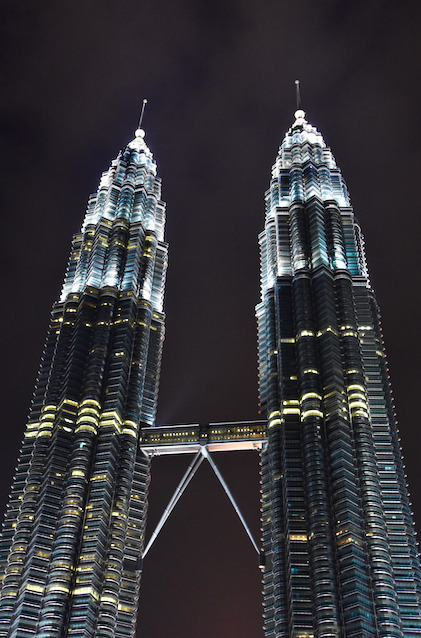
Petronas Towers
We walked to KLCC park, a 50-acre garden with man-made lakes and fountains, located directly across from the twin towers. We were just on time to catch the final musical fountain show, where fountain displays are choreographed to music and lights, set against KLCC’s impressive skyline.
Capping off a busy day in Kuala Lumpur, our group of four headed back to Chinatown, where we set up camp at our hostel’s rooftop cocktail bar, swapping stories late into the night.
Day 146 – Kuala Lumpur
Given the overpowering heat from the day before, Caroline, Bart and I decided to go on the hunt for a rooftop pool for a day of R&R. We were lucky that Mingle had a sister hostel – Sky Society, and our host was able to get us passes to the rooftop pool on the 37th floor for free. Not quite knowing what to expect, we jumped in a Grab and headed out of Chinatown to the neighbourhood of Putra, packing a lunch, towels and drinks for the day. After going through many layers of security, (where we were certain we would be turned away!), we finally made it to the rooftop infinity pool. Considering we hadn’t paid for anything aside from our transit, I was stunned by the city view along the horizon. We had a perfect view of the Petronas Twin Towers, The Menara Tower, and the distant hills beyond the city limits. We jokingly told ourselves that we had found the backpackers’ answer to Marina Bay Sands! We spent the remainder of the afternoon soaking up the sun and plunging in the pool to cool off, all while admiring KL’s impressive skyline.

In the late afternoon, we boarded a train back to Chinatown, showering and changing before heading out for another streetside dinner of delicious Malaysian food. As the evening fell, we caught a Grab to Heli Lounge Bar, located next to the Menara Tower. Heli Lounge Bar is essentially a fully functional helicopter pad by day, which at night converts into the coolest rooftop bar I have ever seen. Unbelievably, there was nothing by retractable rope separating us from the edge of the helipad, and we had unobstructed, 360-degree views of the surrounding cityscape. We found lounge chairs on the edge of the helipad, and enjoyed several aviation-themed cocktails, watching the daylight fade over Kuala Lumpur. As night fell, a sea of twinkling lights stretched as far as my eye could see. It was truly a night I will never forget.
0 notes
Text
Read More 25 Easy (and Cheap!) Ways to Lose 5 Pounds
The following post 25 Easy (and Cheap!) Ways to Lose 5 Pounds is republished from Eat This Not That by Eat This, Not That! Editors
A lot has changed since the days when a fat belly indicated a fat wallet. Now, people pay more for the healthy stuff while the least expensive foods are often the ones packed with waist-widening calories.
But just because you’re on a budget doesn’t mean you can’t lose a few pounds without breaking the bank. To prove it’s possible, we checked in with some of the nation’s leading weight loss experts and asked them how to get lean for less. The following tips are simple things that fit easily into your life, won’t empty your wallet, and can help whittle down your waistline without emptying your wallet. Once you see how affordable it is to take control of the chub, be sure to check out 42 Ways to Lose 5 Inches of Belly Fat.
1
Cook in Bulk
Cook at home and cook in bulk, suggests registered dietitian Lauren Minchen. “Depending on how frequently you eat out, cooking your food at home can save you hundreds of dollars a month. And cooking in bulk is great if you’re time-strapped. It saves you time while allowing you to monitor the ingredients, calories, and portions in your meals. Win win win!” Not sure what to make? Soups are super easy to make and will last you all week. These 20 Best-Ever Fat Burning Soups are many of our editor’s go-tos.
2
Get Competitive
Register for a race or competition. They’ll cost you anywhere from $35 to $125 dollars, but the training aspect, which can last for months, is practically free. “There’s no better way to motivate yourself to get up from your office chair than knowing you have a race coming up,” says registered dietitian nutritionist Michelle Dudash. “Plus, running is one of the cheapest sports you can do because the only special equipment you need is good pair of running shoes and a training program, which you can get online for free.” Looking for a healthy way to recover after your workouts? Whip up one of these 23 Best Protein Shake Recipes.
3
Make Eggs Your Friend
“Eggs are very inexpensive and have been shown over and over to help with weight loss,” says registered dietitian Cassie Bjork. “What’s more, eggs are considered the most bioavailable source of protein, which means your body digests, absorbs and uses the protein in eggs better than in any other food in the world.” A pricey cut of steak can’t even claim that! To learn more about eggs’ magical weight loss powers, check out our exclusive report What Happens to Your Body When You Eat Eggs.
4
Buy What’s In Season
“If you are going to buy fresh produce, it’s important to know what’s in season and what isn’t,” says registered dietitian Leah Kaufman. Things that are out of season will cost you far more cash than produce that’s just hitting its peak. Registered dietitian nutritionist Sarah Koszyk agrees: “For the winter season, try Brussels sprouts, butternut squash, kale, turnips, persimmons, tangerines and kiwis.” Broccoli, berries, tomatoes and salad greens will be cheapest in the summer, while asparagus, cauliflower and spinach are easiest on your wallet in the spring. And if you’re curious which fruits and veggies pack the biggest nutritional punch, check out these 50 Healthiest Foods on the Planet.
5
Buy Frozen Foods
“Whether you’re on a budget or not, frozen vegetables are a great buy,” says Kaufman. “They’re cheaper than fresh vegetables and contain just as many nutrients.” Wondering how stocking up on the stuff can help you slim down? “Vegetables are vital for weight loss because they’re low in calories and high in fiber. Consuming fiber keeps you feeling fuller longer so you will feel satisfied and won’t be tempted to snack.” But fair warning, not all frozen foods are created equal: If you want those last five pounds to come off quickly steer clear of these 48 Worst Frozen Foods in America!
6
Ditch the Dollar Menu
Pre-made meals may save you time but they aren’t necessarily the healthiest picks and they’ll seriously cut into your budget. “By cutting back on pre-made meals, packaged, and processed snacks you’ll have a lot of room leftover in your food budget for the nourishing, real foods that fuel your body with the nutrients it needs for weight loss,” says Bjork.
7
Meal Prep—Even Snacks
“Grabbing a quick snack, whether it be a snack bar or a piece of fruit costs far more at a coffee shop, airport or gas station than it does at a grocery store or farmer’s market,” warns Dudash. To avoid spending unnecessary cash when hunger strikes, she recommends building a clean eating arsenal stocked with grab-and-go pieces of fruit, like apples, pears, and bananas.
8
Stick to Tap Water
“Don’t blow your budget on sugar-laden beverages that will only stand in the way of your weight loss goal. Instead, sip tap water. This simple swap will save you calories and cash, and supports weight loss by nourishing your cells and flushing out toxins,” explains Bjork. Can’t stand the taste of regular H20? Whip up a batch of one of these 50 Best Detox Waters for Fat Burning and Weight Loss.
9
Adopt a Plant-Based Diet
Research shows that switching to a plant-based diet not only promotes weight loss but also lowers your cholesterol, reduces hypertension and extends lifespan. There’s more good news: A meat-free diet can also save you thousands—yes, thousands—of dollars. “I recently switched from a moderate animal protein diet to a plant-based diet and so far I’ve saved about $40 per week, which will easily add up to savings of $2,000 per year,” says the owner of Naples Personal Training, Dr. Sean M. Wells. That’s enough cash to spend on a tropical vacation! (Hawaii, anyone?) Looking for an easy-to-made addition to your plant-based diet? Consider making some of these 50 Best Overnight Oats Recipes.
10
Make Mondays Special
Can’t imagine giving up your favorite burgers and fillets for good? Consider adopting Meatless Mondays—the campaign that encourages people to kick off their week sans meat. “I’m an advocate for Meatless Monday for both budgeting and ethical reasons,” says personal trainer Ajia Cherry. Although there are many vegetarian and vegan sources of protein, Cherry is a big fan of beans. “Beans, especially dried black beans, are inexpensive and contain heart-healthy antioxidants, filling fiber, iron and muscle-building protein.” Nutritionist Tammy Lakatos Shames, who’s also a proponent of going meat-free once a week, likes to swap ground beef for mushrooms. “If you’re not ready for a complete swap, you can start by mixing meat with mushrooms, it will boost your meal’s fiber and stretch you dollar further,” she explains.
11
See The World As Your Gym
Drop the excuses about how you can’t get to the gym—you can work out anywhere, really. “Shedding pounds and getting healthy doesn’t require a gym, boutique fitness studio or a CrossFit box,” says Wells. “Join a local soccer league or walking group or do bodyweight calisthenics at home. My next door neighbor loves to use his tree for pull ups and dips. If you’re willing to get creative you can save anywhere from $50 to 300 per month—that’s a car payment!” For more trim down tricks from the nation’s foremost fitness experts check out these 25 Weight Loss Tips From The World’s Fittest Men.
12
Pland Around Sales
Before scouring Pinterest for recipes you want to make, check your local market to see what’s on sale, suggests registered dietitian Ilyse Schapiro. “After you know what the best deals are, then plan your meals for the week. Also, sign up for a bonus card at your local market. Rewards programs can save you a lot of money in the long run.”
13
Don’t Take Shortcuts
“Skip the pricey pills and detox juices. They’ll cost you an arm and a leg and most of them don’t work,” warns registered dietitian nutritionist Marisa Moore. A cheaper, more effective solution? These 22 Best Teas for Weight Loss!
14
Think Local
“Not only is the food from a farmers market tastier, it’s cheaper, too,” says Schapiro. “Food bought locally doesn’t have to travel long distances, so the prices tend to be lower. And if you shop at the end of the day, you may get even better deals because the farmers want to get rid of their stock. For even more cheap ways to shed the pounds, check out these 40 Ways to Lose 4 Inches of Body Fat.
15
Shake Up Your Own Protein Drink
“Commercial bars and workout drinks can be very expensive. What’s worse, they offer little more to your body than what basic fruits, vegetables and nuts can provide,” says Wells. “Ounce for ounce, homemade smoothies or snacks will not only be cheaper but probably healthier for you, too.”
16
Repurpose Leftovers
You may not have enough leftovers to squeeze out a second meal, but that doesn’t mean you should throw the food out! “Wasted food is wasted money, says Schapiro. “Leftover fruits and vegetables can always be added to a smoothie or protein shake and vegetable and grain scraps can be added to a soup, a stir-fry, or omelet.”
17
Brew Your Own Cup
Love fancy coffee drinks? Learn how to make slimmed-down versions of your favorites at home, suggests Minchen. Not only will making your drinks save you thousands of dollars, but it will also help keep excess fat off of your frame, too. Our Healthy Starbucks Caramel Frappuccino Copycat Recipe is a great way to get into the make-it-yourself groove!
18
Tune to YouTube
Celebs may pay her the big bucks to whip them into shape, but celebrity trainer Kit Rich says it’s possible to get into your skinny jeans without spending a dime. “The cheapest and easiest ways to lose weight through exercise is by doing YouTube workout videos. There are a lot of fun and effective programs available for free!” And to see the results of your sweat session shine through even faster, check out these 7 Ways to Make Your Workout 500% More Effective.
19
Slip Into Your PJs
Getting a proper night’s rest is totally free and it offers major weight loss perks. “When you don’t get enough sleep, levels of the hormone leptin drop, which increases appetite. This surge in appetite makes comfort food more appealing, which can derail weight loss efforts,” explains personal trainer to the stars Jay Cardiello. “I tell all of my celebrity and professional-athlete clients to get between 6 and 8 hours of sleep per night.” Want to lose even more weight while you sleep? Check out these 30 Things to Do 30 Minutes Before Bed to Get Lean.
20
Order an Appetizer
The average restaurant meal contains a whopping 1,128 calories, according to a 2013 University of Toronto study of 19 sit-down restaurant chains. And those numbers have likely increased since then! To save money and calories while dining out, registered dietitian Yasi Ansari suggests ordering a healthy appetizer (like seared scallops, mushroom caps or a salad) or splitting an entree with a friend.
Looking for more ways to lean out? Be sure to check out these 20 Weight Loss Tricks You Haven’t Tried.
21
Make a List
“Spend a couple of minutes each morning writing out a list of reasons you want to live a fitter and healthier life,” suggests author of the top model fitness guide, Methodology X Dan Roberts. “It won’t be conscious, but doing this exercise will help you make better decisions when choosing food and snacks throughout the day.”
22
Don’t Be Swayed By ‘All-Natural’ Claims
Foods stamped with an “All Natural” label tend to cost more, but since the claim isn’t regulated by the FDA, it doesn’t really mean anything. “Instead, read ingredients and then decide which products are worth more of your hard-earned cash,” suggests Cardiello.
23
Swap Snack Bars for Fresh Fruit
“The average snack bar or bag of chips will cost you two dollars, but a piece of fruit will only cost you 50 cents. Stick with a piece of fruit to save calories, fat and cash on snacks,” says certified dietitian nutritionist Dana James.
24
Eat More Canned Tuna
There’s no doubt that protein sources like chicken breasts, tuna and salmon are healthy, but they’re not the most economical. For that reason, Dudash recommends buying the canned varieties. Not convinced? Consider this: A four pack of canned tuna from Walmart is less than $4. It doesn’t get much cheaper than that!
Eat This! Tip
Worried about the mercury in the tuna? Don’t be. Generally speaking, the smaller the fish, the lower the mercury level. Since canned chunk light tuna is harvested from the smallest fish, it’s safe to consume two to three times a week.
25
Use Your Non-Dominate Hand
Been a righty your entire life? Eat dinner with your left hand. “It takes roughly 15 minutes for your brain to realize that you’re full,” says Cardiello. “To give your mind time to catch up to your mouth, simply switch your fork to non-dominate hand. It may be frustrating, but it’s a simple and unnoticeable way to curb overeating and lose weight.” And for even more must-try slim down tricks, check out these 20 Weight Loss Tricks You Haven’t Tried.
The post 25 Easy (and Cheap!) Ways to Lose 5 Pounds appeared first on Eat This Not That.
0 notes
Photo




My journey started at Super 88 on a Saturday afternoon. I’ve been to the Asian foodcourt area of Super 88, but I was pleasantly surprised when I learned that it was also a supermarket. When I first walked in, it reminded me of my local Indian store. There was an area for vegetables, an area for meats & seafood, and an area for boxed, bottled, and canned goods. I decided that I probably should pick a sauce that I was unfamiliar with, because if I were to cook with it, it would not be too hard to make a dish. I ultimately picked up Hoisin sauce, an Asian sauce that is frequently used in stir-fry’s, marinades, and Asian-styled grilled dishes.
Before I get into the specifics of Hoisin Sauce, I was able to find this product in the sauce aisle of Super 88. This object was next to many different brands of the same product. This tells me that this particular sauce is very popular for Asian dishes. It says on the label that this sauce is popular for stir-fry and can be used as a dipping sauce. On the back of the bottle, apart from the nutritional facts, the label even gives a recipe for a Chinese style meal that could be made using this sauce. The fact that there are many different types of the same objects alludes to the branding and marketing tactics that companies are using. The labeling of this sauce is also very modernized to fit it with today’s consumer culture.
Upon opening the bottle, I noticed that physically, this sauce looks has a dark-brown, color. This product has a very thick constancy, which gives it a high viscosity. When smelling this particular product, I immediately noticed that it had a pungent smell to it and when I tasted it, I noticed it had a very strong salty, and slightly sweet flavor. Before including this sauce in my dinner preparations for the night, I was curious and I did some research about the sauce.
Hoisin Sauce is made from a combination of fermented soy, garlic, vinegar, and usually chili and sweetener. Hoisin sauce adds an “authentic” Asian flavor and thickening color to a stir-fry or noodle dish, and it can also be used as a dipping sauce for egg rolls, spring rolls, or other appetizers. The reason authentic is in quotes is that according to one source, “hoisin sauce has been bottled and sold to the ‘West’ since the late 1970s due its popularity in stir fries found in Western Chinese restaurants.” (Wikipedia) Hoisin sauce is often referred to as Chinese barbecue sauce, because it is used for a variety of purposes, which is very similar to American barbecue sauce. Although this particular sauce is labeled as a Chinese dish, it is “not authentically Chinese and you won't find it in Hong Kong, China, Taiwan, Malaysia or Singapore.” (Wikipedia)
Hoisin sauce is found in the older Cantonese communities in Asia - the migrant Cantonese settlements in Malaysia, Vietnam and other areas within Asia. The communities preserve some of the original food and culture that came from villages of Guangdong in Southern China. The name hoisin is a Romanized version of the Cantonese word for seafood. Although, hoisin sauce contains no seafood, it is used in a variety of seafood dishes. According to one source, hoisin sauce was originally based either on fermented black beans or sweet fermented wheat sauce. Some fermented seafood items as well as other seasonings were then added for extra umami flavor. According to this source, over time manufacturers cut back on the more expensive seafood ingredients. This seems the most likely explanation, because hoisin sauce is more commonly used for ingredients such as pork, and not much for seafood (Sciarrino).
Through this extensive research, I realized that that the path that Hoisin sauce took from Cantonese communities in Asia to “westernized” countries such as the United States is very similar to that of Indian sauces, spices, and dishes. These Indian dishes, much like Hoison Sauce, started off as one thing in their respective cities in India, but slowly were changed by manufactures and restaurants to cater to western customers. A prime example of this is butter chicken. Butter chicken never really used to exist in India but due to its popularity with western customers, it is now widespread in many restaurants both in the US and back in India. This process, which is the same for Hoison sauce can be linked back to the class discussion on modern food. As new technologies, and new ways of reaching parts of the world came to fruition, the possibility of foods that were once thought as strictly confined to one region of the world becoming widespread became clear.
After finishing my research and thinking about where Hoison sauce fit into our broader conversation of modern food, the real fun began: it was time to prepare my dinner. On this particular night, I was with 4 of my friends, and we decided to have an Asian-style dinner. On the menu was 4 different items, as well as an appetizer. For our appetizer we had Pork Gyoza’s. For the main meal, we prepared a Hoisin-soy stir-fry dish, a spicy, basil chicken dish, and a black pepper beef dish. While cooking the vegetables with the sauce for the stir-fry, the end product had a thick consistency. In order to get a better consistency, we added soy sauce to the end product. The soy sauce also served to mute the flavor because the stir-fry was pretty sweet to begin with.
In the end, this was a good experience. I learned a lot about Hoisin sauce and was able to make a pretty good dish for dinner. One of the biggest takeaways form this assignment is that in today’s society, we have access to all different types of food. If we want Mexican, or Italian, or Asian, we can just go to an international market and buy what we need. This access is what defines modern food in today’s culture and society.
Sources:
Sciarrino, Joanna. "The Mysterious Origins of Hoisin Sauce." Lucky Peach. N.p., 08 July 2016. Web. 28 Mar. 2017.
"Talk: Hoisin Sauce." Wikipedia. Wikimedia Foundation, 26 Mar. 2017. Web. 28 Mar. 2017.
-- Kesav Anupindi
0 notes